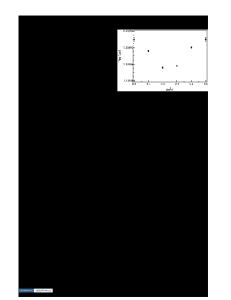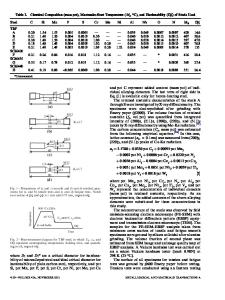Anisotropy in Thermal Expansion of Bainitic Ferrite
- PDF / 1,487,189 Bytes
- 5 Pages / 593.972 x 792 pts Page_size
- 46 Downloads / 390 Views
The mechanical behavior of a wide variety of welded materials and in particular the fatigue performance is influenced to a great extent by the presence of residual stresses;[1-3] it is therefore important to quantify the residual stress state within a component. There are a number of techniques available for this purpose, including destructive methods such as bulk sectioning[4] or hole drilling;[5] and non-destructive methods, which are often based upon diffraction theory.[6-9] Estimation and modeling of residual stresses in welded components from lattice strains associated with a specific reflection {hkl} demand the use of the corresponding plane specific diffraction elastic constants and thermal expansion coefficients, which in general differ from the bulk properties. While the elastic and thermal anisotropy of materials has long been known, experimental evidence of tetragonality of bainitic ferrite has only recently been verified.[10] In the present paper, the anisotropic thermal expansion behavior of bainitic ferrite has been investigated. For this purpose, in-situ thermal tests have been carried out during continuous R.K. DUTTA and H. GAO, Ph.D. Researchers, and M. AMIRTHALINGAM, Research Fellow, are with the Materials innovation institute M2i, Mekelweg 2, 2628CD Delft, The Netherlands, and also with the Department of Materials Science and Engineering, Delft University of Technology, Mekelweg 2, 2628CD Delft, The Netherlands. Contact e-mails: [email protected], [email protected] R.M. HUIZENGA, Research Support, M.J.M. HERMANS, Assistant Professor, and I.M. RICHARDSON, Professor, are with the Department of Materials Science and Engineering, Delft University of Technology. A. KING, formerly with the European Synchrotron Radiation Facility, 6 Rue Jules Horowitz, BP 220, 38043 Grenoble Cedex, France, is now with the Synchrotron Soleil, l’Orme des Merisiers, Saint-Aubin BP 48, 91192 Gif-sur-Yvette Cedex, France. Manuscript submitted July 7, 2014. Article published online september 4, 2014 METALLURGICAL AND MATERIALS TRANSACTIONS A
cooling in a high-energy X-ray diffractometer. The data reported are of considerable significance, since they allow an accurate determination of the thermal stress states from the measured local d-spacings between lattice planes. In our experiments, the as-received steel was homogenized followed by quenching and tempering to produce a consistent tempered martensitic microstructure (Figure 1(a)). Tensile specimens (Figure 1(b)) having a 1 9 1 mm2 square cross section and a gage length of 16 mm were electro-discharge machined from heat treated blocks. The loading axis was chosen parallel to the transverse rolling direction. High-energy synchrotron X-ray diffraction was used to probe the bulk response of (poly-phase) crystallites under in-situ thermal mechanical cycles. In-situ synchrotron diffraction experiments were carried out at the ID11 beam line of the European Synchrotron Radiation Facility (ESRF) in Grenoble, France. To evaluate the coefficient of thermal expansion, several tests were performed using
Data Loading...











